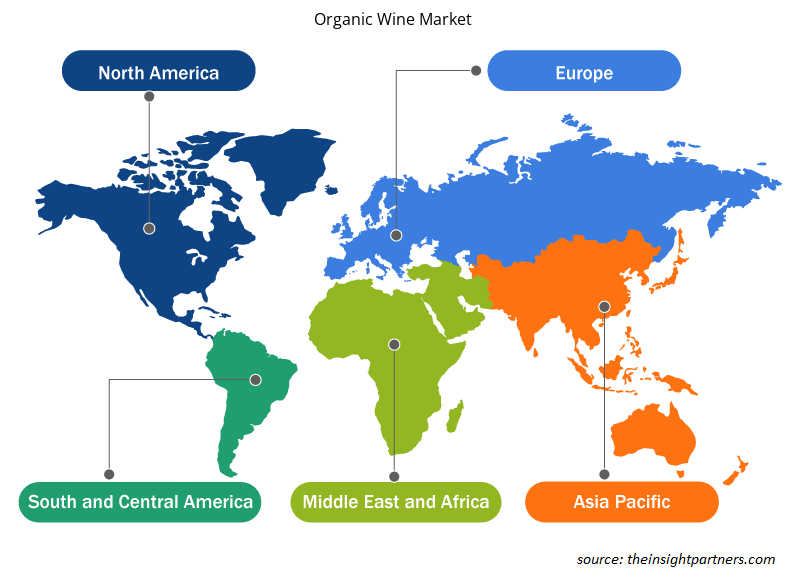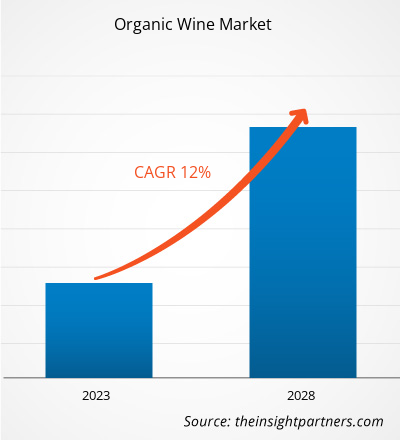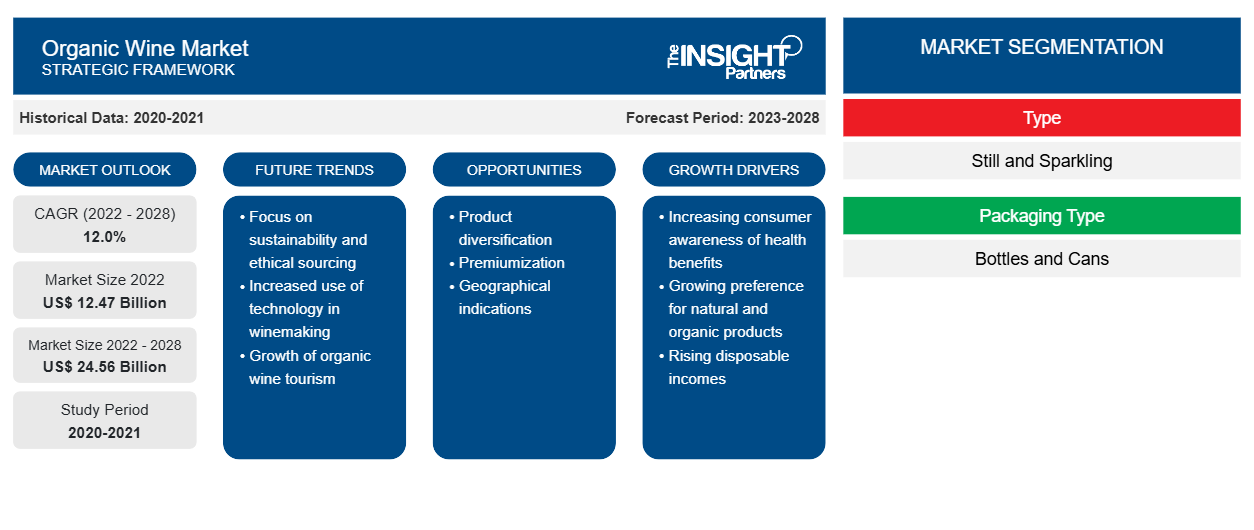オーガニックワイン市場は、2022年の124億7,120万米ドルから2028年には245億5,714万米ドルに達すると予測されています。2022年から2028年にかけて12.0%のCAGRで成長すると予想されています。
市場の成長は、消費者のオーガニックで持続可能な食品や飲料に対する好みが急速に高まっていることに起因しています。最近、人々のライフスタイルや社会的価値観は進化しており、オーガニックワインなどのオーガニック飲料の需要が高まっています。さまざまな製品にアクセスできるようにするデジタルテクノロジーは、オーガニックワインの需要をさらに促進しています。オーガニックワインは、さまざまなフレーバーとパッケージで入手できます。たとえば、赤ワイン、白ワイン、ロゼワインは、さまざまなサイズのボトルや缶に詰められており、消費者の選択肢が増えています。さらに、持続可能な農業を支持する政府によるイニシアチブの増加により、オーガニックワインの生産が増加しています。オーガニックワインの入手しやすさと製品の利点に対する認識が高まっていることが、オーガニックワインの需要に大きく貢献しています。
2021年、ヨーロッパは世界のオーガニックワイン市場の重要なシェアを占めました。ただし、北米は予測期間中に市場で最も高いCAGRを記録すると予測されています。北米のオーガニックワイン市場は、米国、カナダ、メキシコに分割されています。米国は、量でワインの主要消費国の1つです。国連が発表したデータによると、この国ではオーガニックのブドウ園も増えており、ヨーロッパからのワインの輸入も急増している。
要件に合わせてレポートをカスタマイズする
このレポートの一部、国レベルの分析、Excelデータパックなど、あらゆるレポートを無料でカスタマイズできます。また、スタートアップや大学向けのお得なオファーや割引もご利用いただけます。
- このレポートの主要な市場動向を入手してください。この無料サンプルには、市場動向から見積もりや予測に至るまでのデータ分析が含まれます。
COVID-19パンデミックがオーガニックワイン市場に与える影響
COVID-19パンデミックは、長期にわたるロックダウン、製造ユニットの閉鎖、渡航制限、国際貿易禁止、サプライチェーンの混乱、原材料供給の不足により、運用効率の面で製造部門に大きな混乱をもたらしました。これは最終的にオーガニックワイン市場の妨げとなりました。流行による経済減速による食品・飲料業界の混乱も市場の成長を妨げました。しかし、以前に課された制限がさまざまな国で緩和されているため、ビジネスは回復しています。一時的な混乱の後に回復したことで、オーガニックワイン市場は高い成長を遂げました。
複数の国政府によるCOVID-19ワクチンの導入により状況はさらに緩和され、世界中でビジネス活動が増加しました。さらに、いくつかの国の政府は、COVID-19パンデミックの経済的影響を緩和するために、近代的で技術的に高度なインフラストラクチャを開発することを計画しています。ロックダウン中、消費者はホテル、レストラン、バーからワインを購入する代わりに自分でワインを購入したため、オーガニックワインの売上が大幅に増加しました。そのため、COVID-19パンデミックの悪影響にもかかわらず、オーガニックワイン市場は今後数年間で大幅に成長すると予想されています。
市場分析
オーガニック製品への嗜好の高まり
オーガニックワインは、有機農業の慣行に従ったブドウから作られているため、ますます人気が高まっています。政府機関は、人工肥料や化学肥料、殺菌剤、殺虫剤、除草剤の使用を禁止しています。オーガニックワインは、抗酸化物質、ビタミン、ミネラルを多く含むため、より健康的です。赤ワインに含まれるレスベラトロールは、コレステロールを下げ、がんを予防します。USDA Organic、Demeter、Eco Cert などのいくつかの組織が、オーガニックワインの生産を規制し、サポートしています。
タイプベースの洞察
タイプに基づいて、世界のオーガニックワインの市場規模は、スティルワインとスパークリングワインに分かれています。2021年には、スティルワインのセグメントがより大きな市場シェアを占めました。ただし、予測期間中はスパークリングワインのセグメントの方が高いCAGRで増加すると予想されます。ほとんどのスティルワインはすぐに飲めるように開発されていますが、最適なセラー条件でボトル熟成させるように製造されるものもあります。これらのスティルオーガニックワインは、発酵させたブドウジュースから作られています。さらに、スパイスやフルーツの香りが誘発されたさまざまなバリエーションが用意されているため、スティルオーガニックワインの需要は高まると予想されています。その結果、スティルオーガニックワインのセグメントは予測期間中に増加すると予想されます。
Avondale、Elgin Ridge Wines、Kendall-Jackson、The Organic Wine Company、Bronco Wine Company、King Estate Winery、Grgich Hills Estate、Emiliana Organic Vineyards、Società Agricola Querciabella Spa、および Frey Vineyards は、オーガニック ワイン市場で事業を展開している企業です。これらの企業は、市場に幅広い製品ポートフォリオを提供しています。これらの企業は発展途上地域に拠点を置いており、市場に有利な機会を提供しています。市場プレーヤーは、顧客の要件を満たす高品質で革新的な製品を開発しています。
オーガニックワイン市場の地域別洞察
予測期間を通じてオーガニック ワイン市場に影響を与える地域的な傾向と要因は、Insight Partners のアナリストによって徹底的に説明されています。このセクションでは、北米、ヨーロッパ、アジア太平洋、中東、アフリカ、南米、中米にわたるオーガニック ワイン市場のセグメントと地理についても説明します。

- オーガニックワイン市場の地域別データを入手
オーガニックワイン市場レポートの範囲
| レポート属性 | 詳細 |
|---|---|
| 2022年の市場規模 | 124.7億米ドル |
| 2028年までの市場規模 | 245.6億米ドル |
| 世界のCAGR(2022年 - 2028年) | 12.0% |
| 履歴データ | 2020-2021 |
| 予測期間 | 2023-2028 |
| 対象セグメント | タイプ別
|
| 対象地域と国 | 北米
|
| 市場リーダーと主要企業プロフィール |
|
オーガニックワイン市場のプレーヤー密度:ビジネスダイナミクスへの影響を理解する
オーガニックワイン市場は、消費者の嗜好の変化、技術の進歩、製品の利点に対する認識の高まりなどの要因により、エンドユーザーの需要が高まり、急速に成長しています。需要が高まるにつれて、企業は提供品を拡大し、消費者のニーズを満たすために革新し、新たなトレンドを活用し、市場の成長をさらに促進しています。
市場プレーヤー密度とは、特定の市場または業界内で活動している企業または会社の分布を指します。これは、特定の市場スペースに、その市場規模または総市場価値に対してどれだけの競合相手 (市場プレーヤー) が存在するかを示します。
オーガニックワイン市場で事業を展開している主要企業は次のとおりです。
- ケロッグ社
- アボンデール
- エルギンリッジワインズ
- ケンドール・ジャクソン
- オーガニックワインカンパニー
免責事項:上記の企業は、特定の順序でランク付けされていません。

- オーガニックワイン市場の主要な主要プレーヤーの概要を入手
レポートの注目点
- オーガニックワイン市場における進歩的な業界動向は、プレーヤーが効果的な長期戦略を策定するのに役立つ
- 先進国市場と発展途上国市場で採用されているビジネス成長戦略
- 2020年から2028年までのオーガニックワイン市場の定量分析
- オーガニックワインの世界需要の推定
- 業界で活動するバイヤーとサプライヤーの有効性を示すポーターの5つの力の分析
- 競争市場の状況を理解するための最近の動向
- 市場動向と展望、オーガニックワイン市場の成長を牽引・抑制する要因
- 商業的利益の基盤となる市場戦略を強調し、市場の成長につながる意思決定プロセスを支援する
- さまざまなノードにおけるオーガニックワイン市場の規模
- 市場の詳細な概要とセグメンテーション、およびオーガニックワイン業界の動向
- 有望な成長機会のあるさまざまな地域のオーガニックワイン市場の規模
「2028年までの世界のオーガニックワイン市場分析」は、世界のオーガニックワイン市場のトレンド分析に特に焦点を当てた、食品および飲料業界の専門的かつ詳細な調査です。このレポートは、詳細な市場セグメンテーションで市場の概要を提供することを目的としています。
オーガニックワイン市場は、タイプ、パッケージタイプ、流通チャネル、および地域に分類されています。タイプに基づいて、市場はスティルワインとスパークリングワインに分かれています。パッケージタイプに基づいて、市場はボトルと缶に分かれています。流通チャネルに基づいて、市場はスーパーマーケットとハイパーマーケット、専門店、オンライン小売、および直接販売に分割されています。地域別に見ると、市場は北米、ヨーロッパ、アジア太平洋(APAC)、中東およびアフリカ(MEA)、および南米と中米に大まかに分割されています。
企業プロフィール
- アボンデール
- エルギンリッジワインズ
- ケンドール・ジャクソン
- オーガニックワインカンパニー
- ブロンコワインカンパニー
- キング エステート ワイナリー
- グリーギッチヒルズエステート
- エミリアナ オーガニック ヴィンヤード
- ソシエタ アグリコラ クエルチャベッラ スパ
- フレイ ヴィンヤーズ
- 過去2年間の分析、基準年、CAGRによる予測(7年間)
- PEST分析とSWOT分析
- 市場規模価値/数量 - 世界、地域、国
- 業界と競争環境
- Excel データセット
最新レポート
関連レポート
お客様の声
購入理由
- 情報に基づいた意思決定
- 市場動向の理解
- 競合分析
- 顧客インサイト
- 市場予測
- リスク軽減
- 戦略計画
- 投資の正当性
- 新興市場の特定
- マーケティング戦略の強化
- 業務効率の向上
- 規制動向への対応





















 無料サンプルを入手 - オーガニックワインマーケット
無料サンプルを入手 - オーガニックワインマーケット